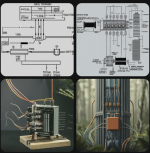ruxton.stanislaw Spammer
Suspended Member
- Location
- Arkansas
- Occupation
- Laboratory Engineer
Solid-state transformers (SSTs) are a promising technology with the potential to revolutionize the electrical distribution network. Here's a glimpse into their future:
Potential Benefits:
While there are challenges, the potential benefits of SSTs are significant. Here's what the future might hold:
Copyright-free abstract concept art (use your imagination ):
):

Potential Benefits:
- Improved Efficiency: SSTs can potentially offer higher efficiency compared to traditional transformers, leading to reduced energy losses within the grid.
- Enhanced Reliability: Their modular design and digital controls might improve grid reliability and enable faster fault detection and isolation.
- Power Quality Management: SSTs can potentially integrate power quality management features like voltage regulation and reactive power compensation.
- Integration of Renewables: They can facilitate the integration of renewable energy sources like solar and wind power into the grid by managing power fluctuations.
- Reduced Footprint: SSTs can be more compact than traditional transformers, making them suitable for space-constrained urban environments.
- Cost: Currently, SSTs are more expensive than traditional transformers. Cost reduction through technological advancements and economies of scale is crucial for widespread adoption.
- Technical Maturity: SST technology is still under development, and further research is needed to address technical challenges related to power handling capacity, efficiency optimization, and long-term reliability.
- Standardization: Standardization of design and communication protocols is necessary for seamless integration with existing grid infrastructure.
While there are challenges, the potential benefits of SSTs are significant. Here's what the future might hold:
- Gradual Adoption: Initially, SSTs might be used in specific applications like renewable energy integration projects or in locations with critical power needs.
- Hybrid Solutions: Hybrid solutions combining traditional transformers with SST functionalities might be a stepping stone towards wider adoption.
- Cost Reduction and Technological Advancements: As technology matures and production scales up, the cost of SSTs is expected to decrease, making them more competitive.
- Regulatory Environment: Government policies and regulations that encourage innovation and investment in smart grid technologies can accelerate the adoption of SSTs.
Copyright-free abstract concept art (use your imagination


